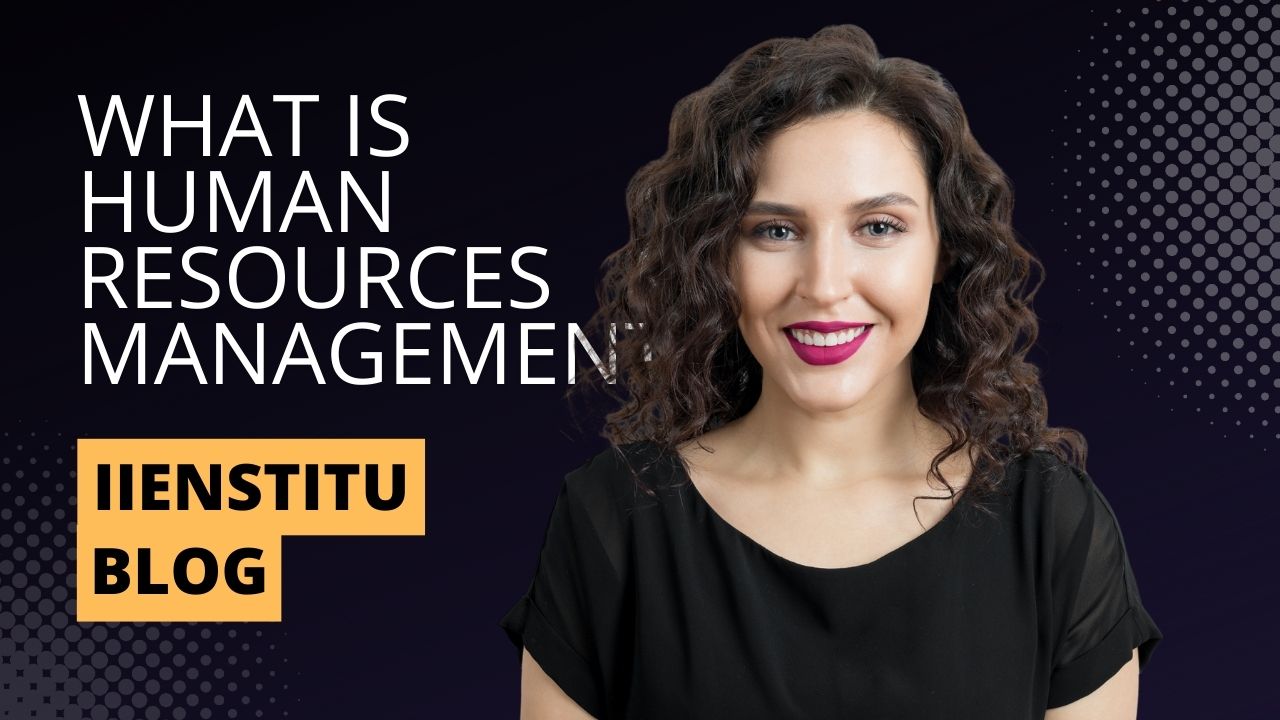
Human resources management (HRM) is managing employees in an organization. It includes planning and implementing personnel policies, overseeing employee relations, and ensuring that employees are recruited, selected, trained, developed, and rewarded to contribute to their goals. HRM is a critical function in any organization, and it plays a crucial role in achieving success. Therefore, it is more important than ever to have a well-developed HRM program in today's competitive business environment.
Defining Human Resources Management: What Does HRM Mean?
Human resource management (HRM) is a broad field that encompasses a variety of activities. However, at its core, HRM is about managing people effectively to achieve organizational objectives.
On the surface, managing people may seem like a simple task. After all, it's not rocket science, right? WRONG. Managing people is one of the most challenging and complex jobs out there. Sure, anybody can be a manager, but not everybody can do it well. Being a good manager is understanding that people are not machines. They have emotions, desires, and motivations that need to be considered. In addition, they need to be given clear direction and expectations. A good manager also knows how to delegate and when to step in and take charge.
Human resource management is the hardest part of managing people for several reasons:
There are often a lot of people to work with. This can be a challenge in terms of coordination and communication.
Each person has their own individual needs and goals. As a result, it can be challenging to create a one-size-fits-all approach that works for everyone.
Human resources managers need to deal with conflict effectively.
With so many people in close quarters, conflict is bound to arise from time to time. Managing conflict can be difficult, but it's essential for keeping the peace in the workplace. All in all, human resource management is a challenging but essential process of managing people.
This process entails everything from recruiting and hiring employees to provide training and development opportunities, setting employee compensation and benefits, and managing performance. HR professionals must effectively communicate with people from all walks of life to build successful relationships. To be successful, HR professionals must have strong communication skills and understand the motivations behind human behavior. In addition, they must be able to work with people from all walks of life to find the best candidates for open positions.
Additionally, they must be well-versed in labor laws and regulations and can resolve conflict. With the ever-changing landscape of the workforce, HR professionals play an essential role in ensuring that organizations can adapt and thrive.
360-Degree Feedback: An In-depth Analysis of Its Implications & Impact
HR Auditing: Comprehensive Insight into Organizational Assessment
HR Research: Decoding the Imperative Role in Organizational Success
What did human resources mean in the 1960s?
In the 1960s, the term "human resources" was first used to describe the department within a company responsible for managing employee records. The human resources department was responsible for keeping track of employee absences, vacation days, and other information. The term "human resources" gradually encompasses all of the functions of managing employees, including recruitment, training, and development. Today, human resources is an essential part of any organization, and the role of human resources has evolved significantly since the 1960s.
The term "human resources" has been used in various ways. Initially, it referred to the department within a company responsible for managing employee records and benefits. However, as the role of HR has evolved, the definition has changed to encompass a much broader range of responsibilities. For example, human resources are responsible for recruiting and hiring, training, and developing employee relations and payroll.
In other words, human resources are now accountable for all aspects of a company's workforce. Furthermore, as the crew has become increasingly diverse and globalized, so too has the role of human resources. With such a broad set of responsibilities, it's no wonder that the definition of human resources has changed dramatically over time.
The future of HR is often spoken about in hushed tones, as though it were some dark mystery. However, there is no reason to be worried about the future of HR. In fact, HR is one of the few fields increasing in importance. As the world becomes more globalized and competitive, companies are looking for ways to better manage their human resources. This means that HR professionals will continue to be in high demand in the years to come. So, if you're thinking about a career in HR, rest assured that it will continue to exist in the future.
Defining Human Resources Management: What It Is and What It Does
Human resources management (HRM) is recruiting, selecting, orienting, training, and appraising employees.
HRM also deals with employee benefits, safety, wellness, employee motivation, communication, and training. To be effective, HRM must be aligned with the organization's strategic goals.
In other words, HRM must contribute to achieving the organization's objectives.
The goal of HRM is to create a productive and motivated workforce. By aligning HRM with the organization's strategic goals, organizations can ensure that their human resources are being used effectively and efficiently. The role of human resources management has become increasingly important in recent years as organizations have come to recognize the importance of their human capital.
With the advent of the knowledge economy, organizations are looking for ways to create a competitive advantage by attracting and retaining the best talent.
The term "knowledge economy" was first coined by Peter Drucker in 1959, and it has been used to describe the increasingly important role that knowledge and information play in the modern economy. In recent years, the knowledge economy has been one of the most significant drivers of economic growth, and it has had a profound impact on the way businesses operate. Indeed, the development of the knowledge economy has caused a significant change in HR.
The traditional model of HR, which focuses on transactional tasks such as payroll and benefits administration, is no longer sufficient in today's business environment. Instead, HR must now develop and retain talent and create an organizational culture that supports innovation and creativity.
The knowledge economy has also led to a more globalized labor market, and HR must now be prepared to recruit and retain employees worldwide. In short, the development of the knowledge economy has been a game-changer for HR, and the best organizations have been able to adapt their HR strategies to this new reality.
Human resources management plays a crucial role in this process by providing a framework for identifying and developing the skills and competencies required for success in the knowledge economy. Therefore, human resources management is essential for any organization that wants to stay ahead of the competition in today's global economy.
The definition of human resource management and its essential role in businesses today
Human resource management (HRM) is overseeing an organization's employees. This includes recruiting, hiring, training new employees, and managing existing staff. HRM is an essential part of any business, as it helps to ensure that the company has a productive and engaged workforce. There are many different aspects to HRM, and the role of the HR manager will vary depending on the size and structure of the organization. However, some everyday responsibilities include developing employee policies, administering benefits, and investigating workplace issues. There has been a growing focus on HRM in recent years, as businesses increasingly recognize its importance in achieving long-term success. By ensuring that employees are appropriately managed and supported, companies can create a positive work environment that improves productivity and profitability.
Comprehensive Guide To Hr Employee Assistance Support Systems
Hr Meaning Comprehensive Guide To Human Resources Roles Functions
7 Myths about Human Resources Management Definition
When it comes to human resources management, there seem to be a lot of myths and misconceptions floating around. In this blog post in the section, we will look at some of the most common myths and provide you with the actual facts. Debunking these myths once and for all. So, without further ado, let's get started!
Hiring and firing is the only responsibility of a human resources manager.
Any HR manager will tell you that one of the most common misconceptions about their job is that all they do is hire and fire people. In reality, HR managers wear many different hats. They may be responsible for hiring and firing, but they also handle employee relations, benefits administration, and training.
They may develop policies, investigate complaints, or even oversee payroll. In short, HR managers play a vital role in ensuring that a company runs smoothly and that its employees are happy and productive. The next time you see an HR manager walking around the office, remember that they are more than just the person who signs your paycheck-they are the backbone of a successful organization.
Only large companies need human resources managers.
Human resources managers are often seen as being primarily concerned with the needs of large businesses. However, this is simply not the case. Human resources managers play a vital role in companies of all sizes. They are responsible for ensuring that employees are adequately trained and compensated and that working conditions are safe and fair. In addition, human resources managers help to resolve conflicts between workers and employers. They play a vital role in maintaining a healthy and productive workplace. Regardless of the size of the business, human resources managers play an essential role in ensuring its success.
Human resources managers are only responsible for payroll and benefits.
Human resources managers are often thought of as being responsible solely for payroll and benefits. However, this is only a tiny part of what they do. Human resources managers play a vital role in all aspects of an organization, from recruiting and training new employees to develop policies and procedures. They also work closely with other departments to ensure that the organization runs smoothly and efficiently. In short, human resources managers are essential to the success of any organization.
A human resources manager's role is to enforce rules and policies.
One common misconception about human resources managers is that their primary role is to enforce rules and policies. While it is true that enforcing laws is a part of their job, it is far from the only thing they do. In fact, human resources managers play a vital role in developing and implementing policies that help create a positive and productive work environment. They also work closely with employees to resolve conflicts and address concerns. In short, human resources managers play a vital role in ensuring that the workplace is a positive and effective place for all employees.
A human resources manager does not need to have a legal background.
The managers must have a solid legal background in human resources. This is because they will be dealing with sensitive information, including employee records and contracts. Therefore, they need to understand the law surrounding these things to protect both the company and the employees. Additionally, human resources managers often have to resolve disputes between employees. Therefore, having a legal background will help them understand the relevant laws and ensure that everyone is treated fairly. In short, a human resources manager who does not have a solid legal background is likely to cause more problems than they solve.
Human resources managers are only responsible for employee relations.
Human resources managers are often thought solely responsible for employee relations, but this is just one aspect of their job. In reality, human resources managers wear many hats, and their responsibilities can vary greatly depending on the size and needs of their organization. In larger organizations, human resources managers may be responsible for overseeing benefits programs, managing payroll, and developing recruiting strategies. In smaller organizations, they may take on a more generalist role, handling everything from employee relations to training and development. Regardless of the specifics, all human resources managers share one common goal: to ensure that their organization has the talent it needs to be successful. To do this, they must be knowledgeable about all aspects of the employment process, from recruiting and onboarding to performance management and retention. By understanding the diverse responsibilities of human resources managers, it is clear that they play a crucial role in ensuring the success of any organization.
Strategic human resource management definition
Strategic human resource management (SHRM) is a long-term approach to managing people in organizations. It focuses on the future needs of the organization and the resources required to meet those needs. SHRM includes all aspects of working people, from recruitment and selection to training and development, from compensation and benefits to employee relations. SHRM is concerned with both the individual and the collective interests of employees, and it aims to create an environment in which employees can be motivated and productive. The ultimate goal of SHRM is to create a strategic workforce that can help an organization achieve its objectives.
International human resource management definition
International human resource management (IHRM) manages people in organizations that operate in multiple countries. IHRM includes recruiting and selecting employees, training and development, compensation and benefits, and performance management. Because IHRM occurs within a global context, it is necessary to consider cultural differences when designing and implementing HR policies and practices. Additionally, IHRM must also deal with the challenge of managing employees who may be located in different time zones and who may speak other languages. By understanding the unique challenges of IHRM, organizations can ensure that their HR policies are effective in a global setting.
Human resources management (HRM) is a process of managing people in an organization. It includes activities like recruiting employees, orienting and training them, compensating and appraising their work, maintaining employee records, and developing policies related to these aspects. The goal of HRM is to ensure that the employees are productive and satisfied with their work so that the company can achieve its goals. If you're interested in learning more about HRM or want to pursue a career in this field, we offer an online human resources management course that will teach you everything you need to know. This online program will give you a comprehensive overview of all things HRM, from recruiting and training to performance management and dispute resolution. With this knowledge under your belt, you'll be ready to take on any challenge in HRM.

Frequently Asked Questions
What is the definition of Human Resource Management?
Human Resource Management (HRM) is the process of managing people in organizations in a structured and thorough manner. It covers the recruiting of new employees, the retention of existing employees, the provision of management training and guidance, the implementation of rewards and recognition systems, and the optimization of employee performance. HRM also includes the development of policies and procedures, the design of organizational structures, the implementation of employee benefit programs, and the management of employee relations.
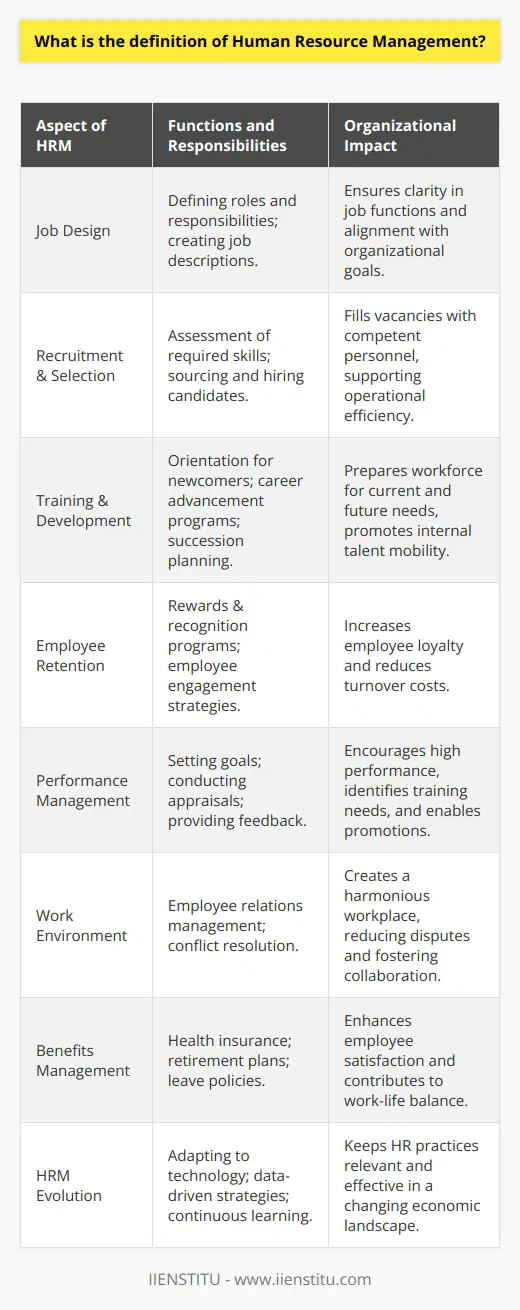
What are the benefits of implementing Human Resource Management practices in an organization?
Improved recruitment and retention of talent: HR practices can facilitate efficient recruitment and selection processes, creating a database of qualified candidates to fill open positions quickly and effectively. Additionally, they can help retain top talent through job satisfaction programs, employee recognition and rewards, and other methods.
Increased employee engagement: HR practices can help improve employee engagement by introducing programs that focus on development and training, recognition and rewards, and employee satisfaction.
Streamlined operations: HR practices can help reduce costs and improve efficiency by automating certain processes such as onboarding, employee records, benefits administration, and payroll.
Improved compliance: HR practices can help ensure compliance with legal and regulatory requirements by ensuring proper record-keeping, developing policies and procedures, and providing employee education.
Improved organizational performance: HR practices can help organizations meet strategic objectives by developing and deploying effective talent management strategies and optimizing organizational structure.
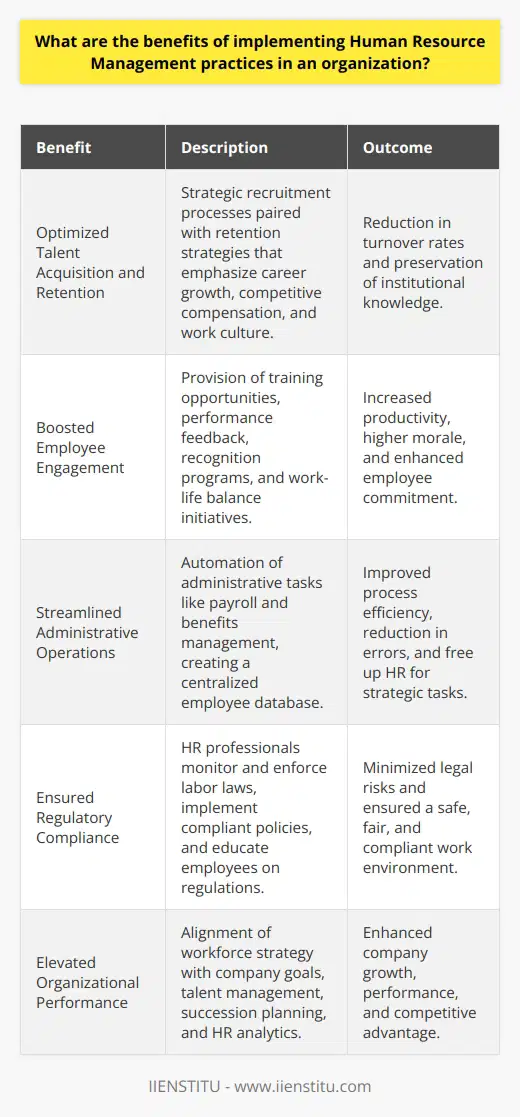
How can Human Resource Management help an organization achieve its goals?
Human Resource Management (HRM) can help an organization achieve its goals by providing the necessary tools and resources for recruitment, training, and development of its human capital. HRM can also help to ensure that the organization is compliant with legal and regulatory requirements, and that the organization is able to attract and retain talented and qualified employees. Additionally, HRM can help to create a positive work environment that encourages creativity and innovation, as well as one that is conducive to strong employee engagement and satisfaction.
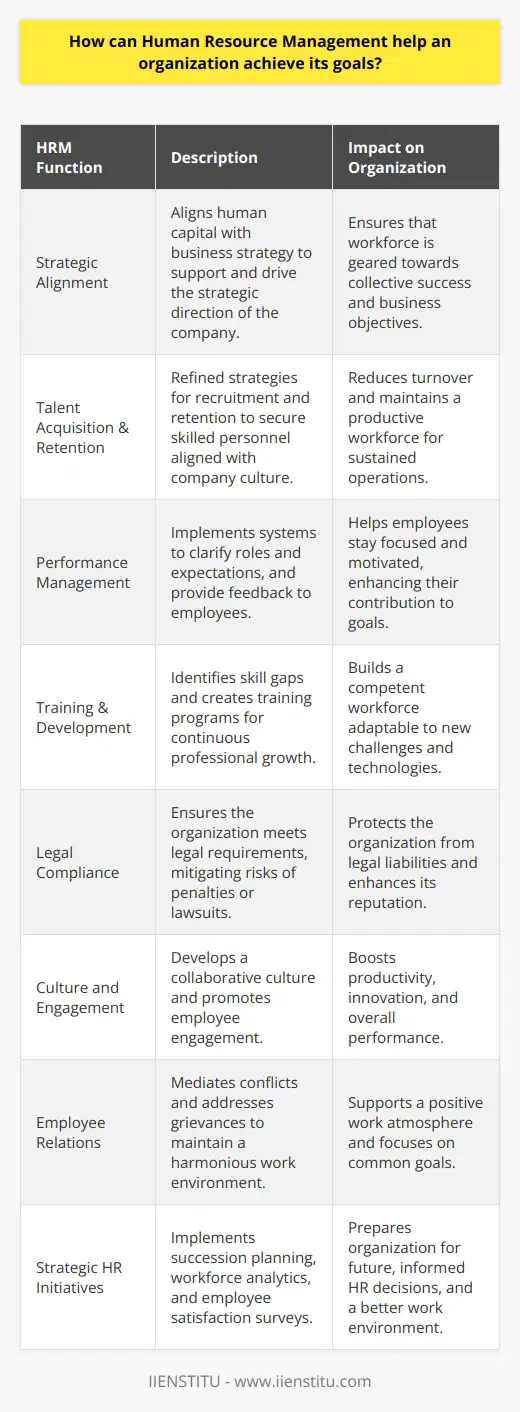
What is the best HR definition in the context of modern organizations?
The Evolution of HR Definitions
In the context of modern organizations, a comprehensive and adaptive definition of Human Resources (HR) is crucial. Traditional HR definitions focus on basic personnel management and administration, which are now considered insufficient in capturing the broader responsibilities and proactive roles of HR in contemporary organizations.
The Strategic Partner Role
The best HR definition for modern organizations encompasses the strategic partner role. This involves aligning HR strategies and practices with an organization's overall goals and objectives, ensuring that the workforce evolves, and optimizing human capital to remain competitive in the dynamic business landscape. The concept of HR as a strategic partner reflects a shift from managing people to empowering and facilitating change, innovation, and organizational growth.
Talent Management and Development
Moreover, the modern HR definition must include the focus on talent management and development. Attracting, retaining, and nurturing top talent is a critical component for organizations to thrive in today's competitive markets. A comprehensive HR approach involves developing and implementing employee engagement, training, and development programs, as well as recognizing employees' strengths and addressing their development needs. This not only benefits the individual employee but also enhances the organization's overall performance.
Inclusive and Sustainable Practices
Lastly, the best HR definition should embrace inclusive and sustainable practices in modern organizations. These practices include promoting diversity and inclusion, ensuring equal opportunities, and maintaining adequate work-life balance for employees. The HR function should also address issues concerning ethics, corporate social responsibility, and environmental sustainability.
In conclusion, the best HR definition for modern organizations is one that encompasses the strategic partner role, talent management and development, and inclusive and sustainable practices. Such a definition captures the shift from traditional personnel management to a more proactive, adaptive, and comprehensive role suited for the complexities of today's business world.

How does human resource management contribute to the overall success of a company?
Significance of Human Resource Management
Human resource management (HRM) plays a crucial role in a company's overall success through distinct and interconnected functions. A well-executed HRM strategy can elevate a company's performance by attracting, retaining, and developing its workforce.
Recruitment and Selection Process
The recruitment and selection process is vital in identifying and acquiring high-quality talent. The HR department ensures that job advertisements reach diverse and qualified candidates, conducting thorough interviews to evaluate suitability. Implementing effective recruitment channels and selection criteria directly impacts the company's ability to hire and retain top-performing employees.
Employee Training and Development
HRM contributes to workforce development by assessing each employee's skill set, determining areas for improvement, and providing access to training resources. Offering professional development opportunities fosters loyalty and helps companies build a skilled workforce which enhances productivity and innovation. Employees who continually refine and expand their skills can drive organizational growth, giving companies a competitive edge.
Performance Evaluation and Feedback
The HR department conducts regular performance evaluations to provide constructive feedback for employees. Timely assessments after project completions or key milestones enable staff members to understand their strengths and weaknesses. By reinforcing positive behaviors and addressing areas of concern, HRM ensures the continuous improvement of an organization's workforce, which bolsters overall company success.
Compensation and Benefits Management
HRM plays an essential role in determining competitive compensation and benefits packages that incentivize employee performance. Offering attractive salaries, health care options, and retirement plans not only aids employee retention but also attracts top candidates by demonstrating an employer's commitment to recognizing and rewarding hard work.
Organizational Culture and Employee Relations
Strong organizational culture is a key component of a company's success, and HRM plays an integral role in fostering this environment through employee engagement initiatives. Regularly conducting employee satisfaction surveys and implementing policies that promote a healthy work-life balance contributes to team morale and improved performance. Furthermore, HRM is responsible for handling and resolving workplace conflicts, ensuring fairness and compliance with employment laws.
In conclusion, human resource management is essential to an organization's overall success by facilitating the acquisition and development of employees while promoting an inclusive and rewarding organizational culture. Through recruitment, training, performance evaluations, compensation management, and employee relations, a robust human resource management strategy can lead to sustainable growth, innovation, and competitive advantage.
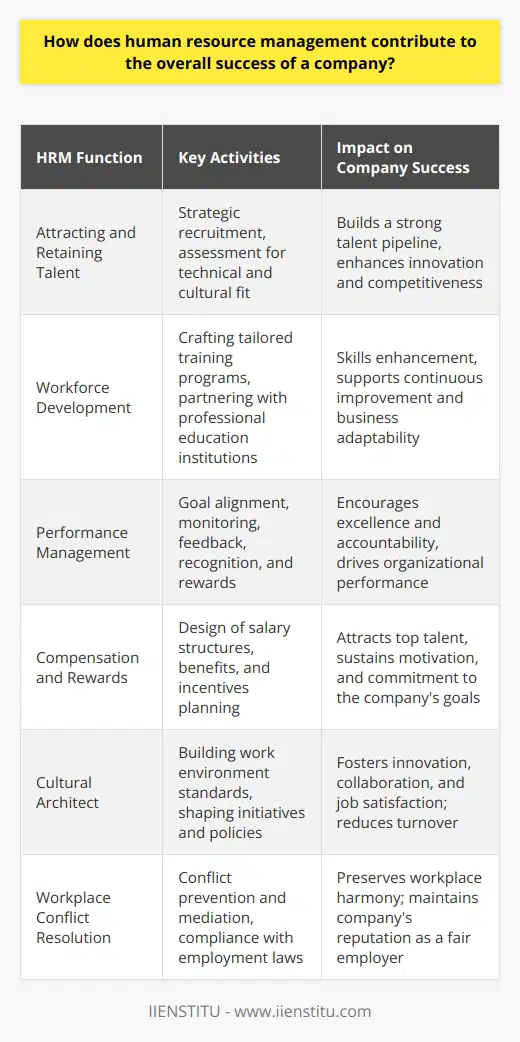
What is the scope of HR functions and responsibilities in terms of employee management and development?
Scope of HR Functions in Employee Management
Human resources (HR) play a vital role in managing and developing employees within organizations. In the context of employee management, HR responsibilities encompass recruitment, selection, and onboarding of talent. This involves posting job advertisements, screening candidates, organizing interviews, and effectively integrating new hires into the organization.
Performance Management and Evaluation
A crucial HR function in employee management includes performance management and evaluation. HR designs and implements performance appraisal systems that help supervisors assess employee performance on a regular basis. This allows organizations to identify high-potential employees, give constructive feedback, and make informed decisions regarding promotions, salary increases, or even termination.
Workplace Health and Safety
Concerning workplace health and safety, HR ensures compliance with relevant legislation and develops policies and procedures to minimize potential hazards. HR also orchestrates safety training and maintains records of incidents and injuries. This contributes to creating a safe and healthy working environment for employees, which directly impacts their well-being, job satisfaction, and productivity.
Employee Relations and Conflict Resolution
HR also focuses on employee relations, which entails creating a positive and fair work environment. This involves addressing concerns, fostering communication, and resolving conflicts to improve employee morale and maintain productivity. HR works with management and employees to promote a culture that values inclusiveness, transparency, and mutual respect.
Training and Development
In terms of employee development, HR is responsible for offering training and growth opportunities that enhance employees' personal and professional skills. HR identifies internal and external training programs, facilitates workshops, and offers e-learning resources to support employee learning and career advancement.
Succession Planning and Retention Strategies
Moreover, HR is accountable for succession planning and implementing employee retention strategies. By identifying top talent and grooming them for future leadership roles, HR ensures a healthy pipeline of qualified individuals to take on new challenges. In addition, HR devises strategies to reduce employee turnover, such as offering competitive compensation packages, providing strong support systems, and promoting a positive work-life balance.
In conclusion, the scope of HR functions and responsibilities in employee management and development is far-reaching, as it covers critical aspects such as recruitment, performance management, workplace safety, employee relations, training, and retention strategies. HR plays a crucial role in maintaining a motivated, skilled, and secure workforce, ultimately contributing to the organization's success.
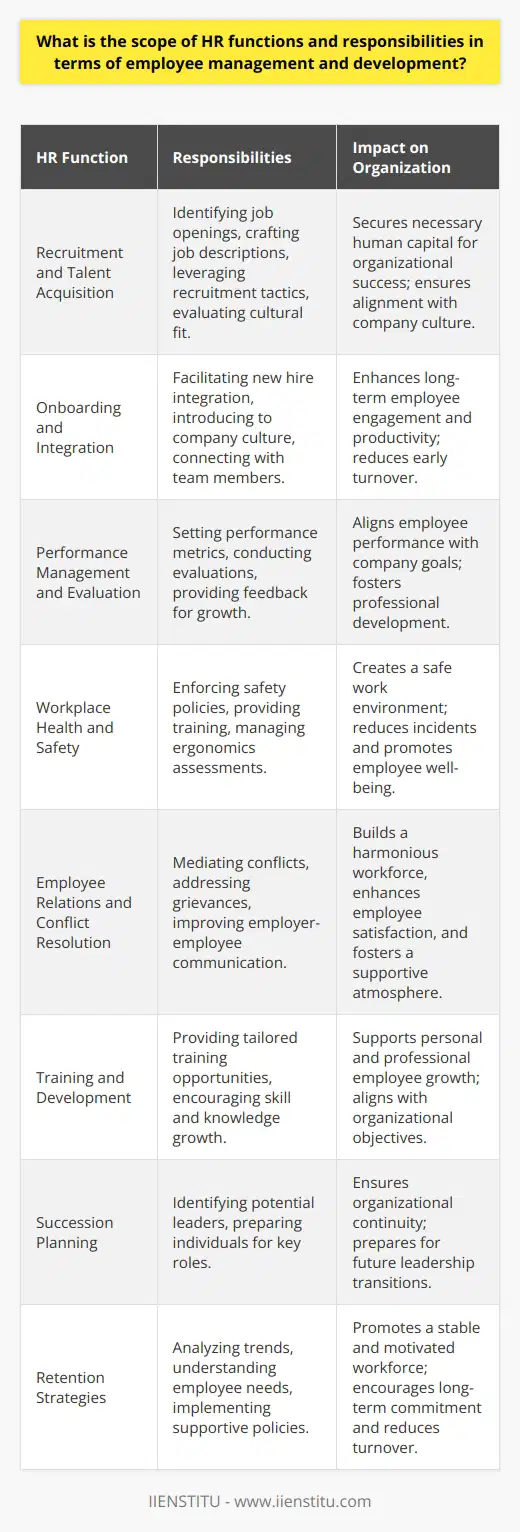
What is the meaning of human resource management in the context of organizational efficiency and effectiveness?
Understanding Human Resource Management
The meaning of human resource management (HRM) in the context of organizational efficiency and effectiveness can be elucidated as the strategic actions undertaken by an organization to ensure optimal performance and utilization of its workforce. HRM is crucial in aligning the organization's goals with its human capital, which is a key factor in achieving desired outcomes.
Role of HRM in Organizational Efficiency
HRM plays a pivotal role in enhancing organizational efficiency by streamlining processes and systems that impact employee productivity. For instance, HRM enables the organization to establish a suitable organizational structure, create well-defined job roles, design performance appraisal systems, and implement effective recruitment and talent acquisition strategies. These initiatives contribute to efficient employee management and overall business functioning, ultimately leading to improved performance and productivity.
Ensuring Employee Effectiveness
A critical component of HRM is fostering employee effectiveness by promoting skill development, motivation, and job satisfaction among the workforce. This is achieved through various HRM interventions such as training and development programs, performance management, incentive schemes, and employee engagement initiatives. These efforts not only improve individual performance but also contribute to creating a positive organizational culture which promotes effectiveness among the workforce as a whole.
Impact of HRM on Organizational Success
In conclusion, the importance of human resource management in the context of organizational efficiency and effectiveness lies in its ability to align an organization's human resources with its strategic objectives. By adopting a comprehensive approach to HRM that addresses employee-related concerns in areas such as recruitment, development, performance management, and motivation, organizations can create a dynamic and capable workforce capable of achieving outstanding outcomes. Thus, efficient and effective HRM practices have direct implications for overall business success and competitiveness in the market.

What is the primary role of a human resource manager in fostering a positive work culture and environment?
Role of HR Manager in Work Culture and Environment Development
Creating a Healthy Work Atmosphere
The primary role of a human resource manager in fostering a positive work culture and environment is to create a healthy and supportive atmosphere. This includes understanding the needs of employees, implementing effective communication strategies, and creating a sense of unity and purpose within the organization. They must act as a mediator between the employer and the employees, striving for an optimal balance between their interests.
Organizing Employee Welfare Programs
To achieve a positive work culture, HR managers should design and organize welfare programs such as employee assistance programs, wellness initiatives, and team-building activities. These programs help employees feel valued, supported, and engaged, ultimately creating a more positive work environment. Moreover, they aid in reducing stress and burnout, contributing to higher employee satisfaction and increased productivity levels.
Implementing Feedback Mechanisms
Another crucial aspect of the human resource manager's role in fostering a positive work culture is the implementation of effective feedback mechanisms. These approaches may differ based on the size and nature of the organization. They can range from simple suggestion boxes to more advanced employee engagement software. These mechanisms enable employees to voice their opinions and concerns, allowing HR managers to continuously improve the work environment.
Organizational Policy Development and Enforcement
Establishing comprehensive organizational policies is vital for a positive work culture. Human resource managers should develop and enforce these policies consistently to ensure that employees feel secure and supported in their workplace. These policies may include anti-discrimination and harassment regulations, equal opportunity employment practices, and guidelines for conflict resolution. By maintaining and promoting fair and ethical practices within the organization, HR managers contribute significantly to developing a positive work environment.
Training and Development Programs
Investing in employee training and development programs is essential for fostering a positive work culture. HR managers must identify skill gaps and provide continuous learning opportunities for employees, enabling them to grow both professionally and personally. By doing so, HR managers not only improve the overall performance of the organization but also boost employee morale and motivation.
In conclusion, human resource managers play a pivotal role in fostering a positive work culture and environment within organizations. Their responsibilities include creating a healthy atmosphere, organizing welfare programs, implementing feedback mechanisms, developing and enforcing organizational policies, and facilitating employee training and development. By focusing on these tasks, HR managers can significantly contribute to the well-being and success of both employees and the organization overall.

In simple terms, how does HR contribute to the overall strategic planning and decision-making processes within an organization?
Role of HR in Strategic Planning
Human Resources (HR) plays a critical role in the strategic planning and decision-making processes within an organization. In essence, HR contributes to this process by ensuring employee alignment with the company's goals and objectives. This involves recruiting, training, and retaining top talent, as well as providing ongoing support in employee motivation and satisfaction.
Employee Recruitment
A crucial aspect of HR's contribution is sourcing the necessary human capital for the organization. By identifying the right candidates for different roles, HR helps in driving the organization towards achieving its strategic goals. They do this through a thorough understanding of the required competencies and skills for each position and by implementing effective recruitment strategies.
Skill Development and Training
Another significant aspect is the development and upskilling of employees to meet both current and future organizational needs. HR designs, implements, and monitors training programs for employees, enabling them to acquire and enhance their competencies. This, in turn, contributes to the overall success of the organization in attaining its strategic objectives.
Employee Retention
HR also plays a pivotal role in employee retention, which is essential for the organization's stability and growth. By establishing a positive work culture, offering competitive compensation packages, and implementing employee engagement programs, HR ensures high job satisfaction and employee loyalty. Consequently, this helps organizations in retaining top talent and minimizing the costs associated with employee turnover.
Performance Management
An essential part of HR's strategic contribution is monitoring and evaluating employee performance. Human Resources manages the performance appraisal process, which assesses the employee's contributions towards achieving the organization's goals. In doing so, HR helps organizations in identifying high-performing individuals and areas that need improvement. This information is then used for making informed decisions on promotions, rewards, and other career development opportunities.
Integration with Overall Strategy
Overall, HR plays a central role in the integration of human capital with the organization's strategic planning and decision-making processes. By aligning employees with the company's vision, HR helps drive organizational performance and success. HR professionals, through their expertise in recruitment, training, retention, and performance management, ensure that the right people with the right skills are in place to achieve the company's strategic goals.
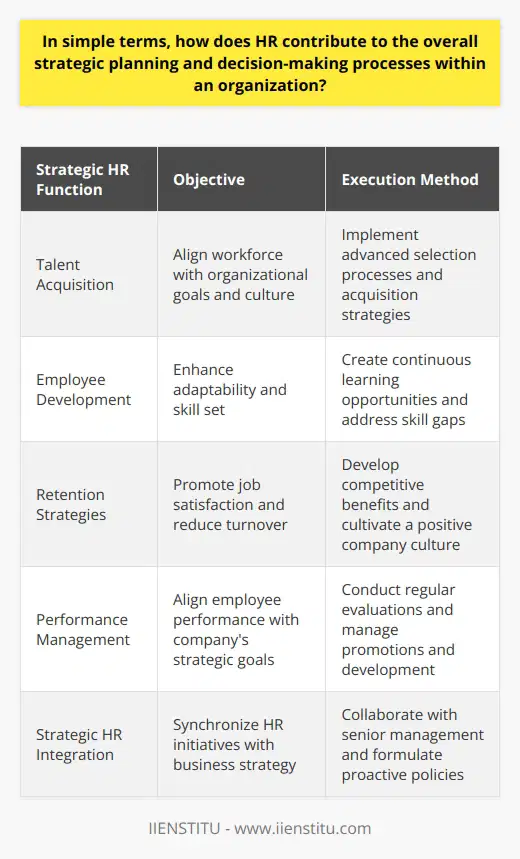
What is the meaning of human resource management in relation to enhancing employee performance and satisfaction?
Defining Human Resource Management
Human Resource Management (HRM) refers to the strategic and coherent approach to managing an organization's most valuable assets – its employees. The main goal of HRM is to optimize the overall productivity and well-being of employees, ultimately driving organizational success.
Role of HRM in Employee Performance
HRM plays a crucial role in enhancing employee performance. By employing comprehensive recruitment and selection processes, HRM ensures that organizations hire individuals best suited for the specific roles and responsibilities. Furthermore, HRM conducts training and development programs to equip employees with the knowledge and skills required to perform their jobs effectively.
HRM in Employee Satisfaction
Employee satisfaction is another important aspect of HRM. By facilitating a healthy work-life balance, providing non-monetary incentives for professional accomplishments, and creating an inclusive and diverse work environment, HRM helps maintain high levels of employee morale. Additionally, HRM plays a pivotal role in addressing employee grievances, hence promoting a positive organizational culture.
Feedback and Performance Appraisal
To enhance employee performance, HRM implements performance appraisal systems that evaluate an individual's job performance regularly. This process provides valuable feedback, enabling employees to identify areas for improvement and set personal development goals. Performance appraisals also promote open communication between managers and employees, fostering a transparent and achievement-oriented work environment.
Employee Benefits and Compensation
To ensure employee satisfaction, HRM is responsible for designing and implementing comprehensive compensation packages, including salary, bonuses, and various monetary and non-monetary benefits. Offering suitable, competitive, and attractive compensation packages contributes to employee engagement and retention, preventing talent loss and ensuring organizational sustainability.
Motivation and Engagement
HRM incorporates motivational theories and practices to keep employees engaged and committed to their work, ultimately driving better performance. By understanding the individual needs and preferences of employees, HRM customizes motivational strategies, such as offering challenging work assignments, promoting collaboration, facilitating professional growth, and recognizing the efforts and achievements of employees.
In conclusion, HRM is integral to enhancing employee performance and satisfaction. By adopting effective recruitment processes, providing training and development opportunities, addressing grievances, designing compensation packages, and incorporating motivation strategies, HRM fosters a supportive and productive work environment that drives organizational success.

What is the best HR definition that encapsulates its evolving role in the modern workplace?
Defining Human Resource Management
The best HR definition that encapsulates its evolving role in the modern workplace is one that emphasizes its strategic and integrative approach, while still maintaining a focus on people management. Human Resource Management (HRM) can be defined as the effective and efficient use of an organization's human capital to achieve the desired objectives through the combination of strategic planning, integration, and people-centered initiatives.
Strategic Shift in HR
A key aspect of this definition is the strategic orientation of HRM. In the modern workplace, HR is no longer merely an operational or administrative function. Instead, HR has evolved into a strategic partner that contributes significantly to the organization's overall performance and long-term success. By aligning its practices and policies with the organization's goals and strategic direction, HR plays a crucial role in shaping the work environment, influencing employee behavior, and creating a competitive advantage. This strategic shift has led to an increasing emphasis on competitive positioning, talent management, and value-added services.
Integrative Approach
The integrative approach manifested in the HRM definition acknowledges the need for HR practices to be interwoven and aligned with overall organizational goals. This approach encourages a holistic perspective on HR activities, as opposed to compartmentalizing them into separate silos. The integration ensures that all HR activities are aligned and work in synergy to support the organization's mission, vision, and objectives. This integration is also critical in a rapidly changing business environment, where organizations must adapt quickly to stay competitive and respond to new challenges and opportunities.
People-Centric Focus
Lastly, a comprehensive HR definition recognizes that the essence of HR lies in its focus on people management. In today's knowledge-driven economy, an organization's human capital has become increasingly important as the primary source of competitive advantage. Consequently, HR must develop strategies for attracting, retaining, and developing a highly skilled and diverse workforce. These strategies include designing employee-centric policies and practices, fostering a culture of continuous learning and professional development, and promoting a positive, inclusive, and supportive work environment.
In conclusion, the best HR definition that encapsulates its evolving role in the modern workplace is a combination of strategic planning, integration, and people-centered initiatives. This definition acknowledges the strategic, integrative, and people-centric aspects of HRM, setting the stage for a more proactive, value-additive, and influential role for HR in today's dynamic organizations. As businesses continue to evolve and face new challenges, HR will need to take up a more prominent role, ensuring that organizations can effectively leverage their human capital to achieve sustained success.
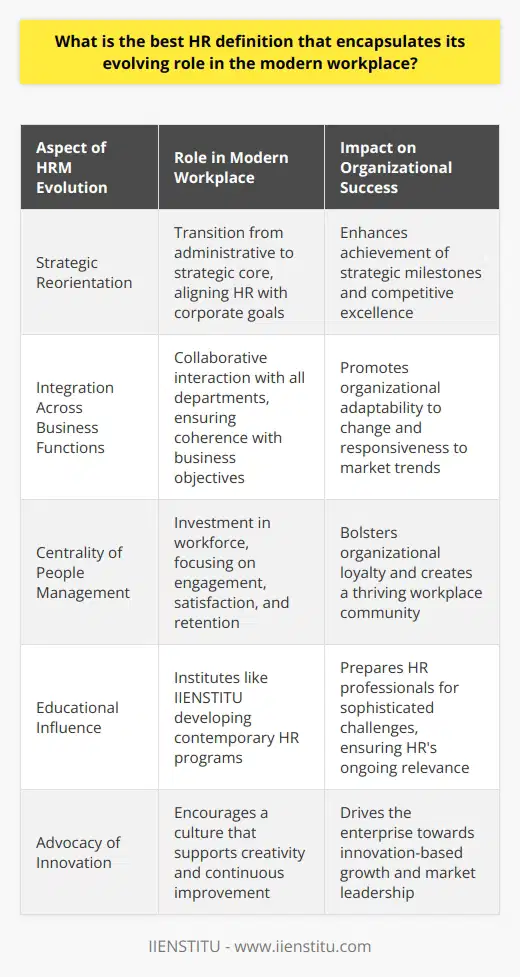
In simple terms, how does HR facilitate strong employee-employer relationships and improve overall business outcomes?
Role of HR in Employee-Employer Relationships
Effective communication is a key tool for Human Resource (HR) professionals to foster strong employee-employer relationships. By providing a platform for open dialogue, HR helps establish trust and reduce misunderstandings among stakeholders. As a result, employees feel valued, motivated, and able to contribute positively to the organization.
Navigating Conflict Resolution
A critical aspect of strong employee-employer relationships is managing conflicts proactively. HR ensures that both parties can express their concerns freely in a neutral environment. By mediating disputes fairly, HR fosters an atmosphere of mutual collaboration and respect, which contributes to increased productivity.
Providing Opportunities for Career Development
HR enhances employee-employer relationships by offering opportunities for career growth and development. By investing in training and skill development, HR enables employees to achieve their career aspirations, resulting in increased job satisfaction and higher retention rates. Further, well-trained employees contribute to overall business outcomes by improving efficiency and innovation within the organization.
Recognizing Achievement and Providing Feedback
HR plays an essential role in recognizing employees' achievements and providing performance feedback. By acknowledging hard work, HR contributes to increased employee morale and engagement, leading to better employer relationships. Additionally, constructive feedback guides employees towards areas of improvement, promoting personal and professional growth, which ultimately benefits the organization.
Balancing Work-Life Integration
Promoting work-life integration is an effective way for HR to strengthen employee-employer relationships. HR can achieve this balance by offering flexibility in schedules, encouraging remote work, or organizing employee engagement programs. By alleviating stress and enabling employees to maintain personal commitments, HR reduces burnout and turnover rates while enhancing overall job satisfaction.
Promoting Diversity and Inclusion
Employing diverse talent and fostering an inclusive work environment is another facet of HR's responsibility in cultivating employee-employer relationships. By implementing policies that reduce bias and promote a fair work environment, HR attracts and retains high-performing employees from various backgrounds. Further, diverse and inclusive workplaces tend to be more innovative, agile, and customer-centric, improving overall business outcomes.
In conclusion, HR is instrumental in facilitating strong employee-employer relationships and improving overall business outcomes through its focus on effective communication, conflict resolution, career development, performance recognition, work-life integration, and promoting diversity and inclusion. By fostering a work culture rooted in trust, mutual respect, and open dialogue, HR ensures that both employees and employers can thrive and achieve their goals.
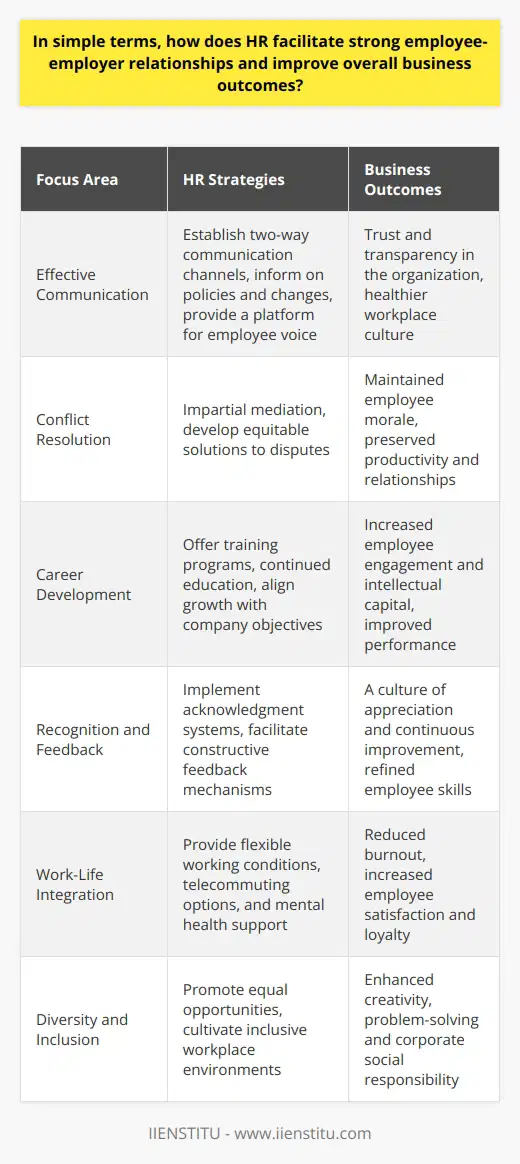
What is the main role of HR in fostering talent development and retention in organizations?
Role of HR in Talent Development
The main role of Human Resource (HR) professionals in organizations is to foster talent development and retention. This is achieved by implementing various strategies that ensure the organization's employees continuously acquire the necessary skills and knowledge needed to contribute positively to the organization's objectives.
Organizational Learning and Development Programs
To achieve talent development, HR implements organizational learning and development programs. These programs provide employees with the opportunity to improve their skills and expand their knowledge base through trainings, workshops, and short courses. As a result, employees can perform better in their roles, leading to increased productivity and career growth.
Performance Management Systems
HR professionals also play a crucial role in developing and implementing performance management systems. Such systems measure employees' performance, provide constructive feedback, and set measurable goals to ensure continuous improvement. By engaging in regular performance reviews, HR can identify potential areas of improvement, enabling employees to work on their skills and abilities, which, in turn, helps organizations retain talent.
Succession Planning and Career Development
Another essential function of HR in fostering talent development is succession planning and career development. HR collaborates with organizational leaders to identify and groom high-potential employees, ensuring a pipeline of experienced and skilled individuals prepared to assume leadership roles. This process involves assessing employees' competencies, establishing clear career development plans, and providing mentoring and coaching opportunities, leading to talent retention and lower turnover rates.
Employee Recognition Programs
In addition to skills development, HR also fosters talent retention through employee recognition programs. By acknowledging and rewarding employees for their hard work, achievements, and dedication, HR can cultivate a positive work environment that motivates employees to stay with the organization. Examples of recognition programs include award ceremonies, bonus schemes, and opportunities for promotions or challenging assignments.
Work-Life Balance Policies
Lastly, HR promotes talent retention by advocating and implementing work-life balance policies that cater to employees' physical and mental well-being. These policies include flexible work arrangements, healthcare benefits, and employee wellness programs. When employees feel that their organization values their well-being, they are more likely to stay engaged, perform at their best, and remain loyal to the organization.
In conclusion, the main role of HR in fostering talent development and retention is achieved through various strategies, ranging from learning and development programs to work-life balance policies. By addressing the diverse needs of employees, HR plays a critical role in ensuring organizational success and competitiveness.
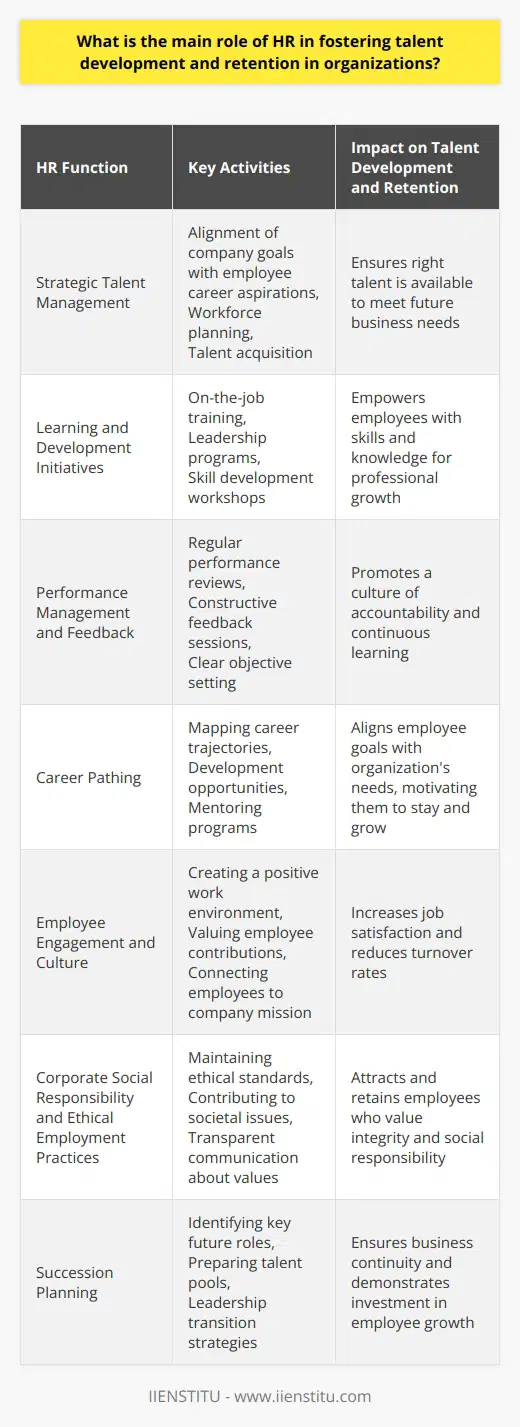
In the context of a dynamic and diverse workplace, what is the best HR definition that emphasizes the importance of inclusion and diversity management?
Defining Inclusive HR Practices
In contemporary workplaces characterized by dynamism and diversity, the best human resource (HR) definition recognizes the significance of inclusion and diversity management. This approach pertains to creating an organizational culture that values and respects every individual's unique differences, fostering an environment where employees actively contribute to the company's objectives, and benefit from equitable opportunities for growth and development.
Importance of Inclusion
Inclusion entails involving employees from different backgrounds, skillsets, and perspectives, ensuring that they feel engaged, supported, and valued by the organization. By adopting inclusive HR practices, companies benefit from an open culture that encourages sharing ideas, innovation, and creativity. As a result, employees experience a greater sense of belonging, increased job satisfaction, and higher retention rates.
Embracing Diversity Management
Diversity management, on the other hand, involves recognizing and respecting various attributes that differentiate individuals, including race, ethnicity, gender, age, and sexual orientation. In this context, effective diversity management entails creating policies and practices that not only prevent discrimination but also promote equality and respect for diversity among employees. This can lead to improved employee performance, increased productivity, and enhanced competitiveness in the marketplace.
Role of HR in Promoting Inclusive and Diverse Workplaces
To emphasize the vital role of HR in fostering inclusion and diversity management, the ideal definition should incorporate the acronym 'HUMAN,' conveying the centrality of human capital in driving organizational success. It stands for 'Harmonizing Unique Multicultural Attributes Neutrally.'
HUMAN represents a comprehensive HR approach that actively engages in promoting an inclusive and diverse workplace, both at the strategic and operational levels. By embracing the HUMAN philosophy, HR professionals can champion equality, mitigate biases, and act as change agents in creating an environment where all employees feel respected, motivated, and empowered to achieve their fullest potential.
Conclusion
In conclusion, the best HR definition in the context of a dynamic and diverse workplace emphasizes the importance of inclusion and diversity management, encapsulated within the HUMAN acronym. By adopting this inclusive and diverse perspective, HR professionals can facilitate a cooperative and collaborative organizational culture that fosters innovation, enhances competitiveness, and ultimately drives business growth.

What is the meaning of human resource management with respect to ensuring legal compliance and ethical practices within a company?
Understanding Human Resource Management
Human Resource Management (HRM) refers to the systematic approach of managing an organization's workforce in a way that maximizes employees' contributions to achieve the overall goals of the company. One of the critical aspects of HRM is ensuring legal compliance and ethical practices are upheld within a company.
Role of HRM in Legal Compliance
HRM plays a vital role in ensuring that an organization meets its legal obligations towards its employees. This involves being informed about current labor laws, creating and implementing policies and procedures that adhere to these laws, and ensuring that employees are aware of their rights and responsibilities. By doing so, HRM minimizes potential legal conflicts and fosters a fair working environment.
Addressing Ethical Concerns
Ethical recruitment and selection: HRM is responsible for developing and promoting fair and transparent recruitment processes to avoid discrimination, bias, and nepotism. This ensures that qualified candidates are provided an equal opportunity to apply for positions and reduces the likelihood of unfair treatment based on irrelevant factors.
Equality and diversity: HRM plays a significant role in promoting a diverse and inclusive workplace by developing policies and procedures that prevent discrimination based on factors like race, age, gender, disability, and religion. This not only ensures compliance with anti-discrimination laws but also contributes to a more positive working environment driven by respect and inclusion.
Employee privacy: It is the responsibility of HRM to develop policies and procedures that safeguard employee privacy and comply with data protection laws. This involves maintaining confidentiality, handling sensitive employee information with care, and respecting employee privacy rights.
Workplace safety: HRM is instrumental in ensuring that companies comply with health and safety regulations to provide a safe and secure working environment. They develop and implement safety policies, conduct risk assessments, and provide training to employees to mitigate workplace hazards.
Ethical behavior encouragement: Another crucial aspect of HRM is promoting ethical behavior in the workplace. This involves creating a code of conduct, providing training on ethical decision-making, maintaining open communication channels for reporting unethical practices, and enforcing disciplinary actions when necessary.
In conclusion, the meaning of Human Resource Management with respect to ensuring legal compliance and ethical practices within a company involves promoting a fair, safe, and law-abiding work environment. It fosters equality, diversity, and ethical behavior, ultimately leading to a more productive and inclusive workplace.
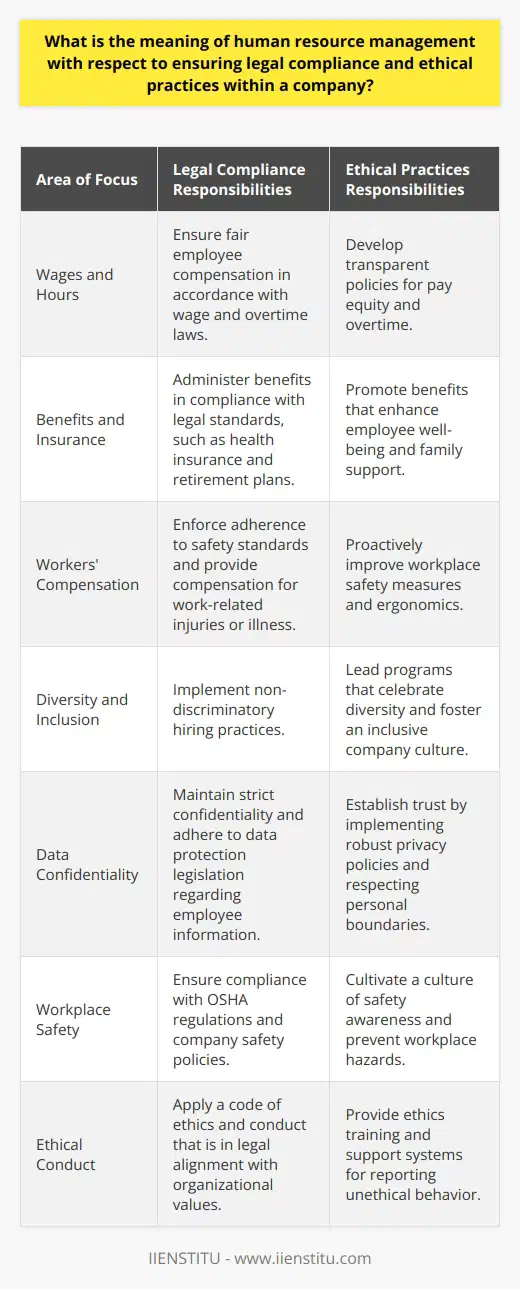
What is the role of the HR in facilitating employee well-being and work-life balance?
Role of HR in Employee Well-being
The Human Resources (HR) department plays a significant role in promoting employee well-being and work-life balance within an organization. They are responsible for developing initiatives that support employees' physical, mental, and emotional health, ultimately contributing to overall job satisfaction and productivity.
Employee Assistance Programs
One way HR facilitates employee well-being is through Employee Assistance Programs (EAPs). These programs provide confidential support services for various personal and work-related issues, such as stress management, financial counseling, and mental health care. By offering EAPs, HR helps employees address challenges that may negatively impact their well-being and job performance.
Flexible Work Arrangements
To ensure work-life balance, HR can implement flexible work arrangements that accommodate employees' varied needs. Options such as remote work, compressed work weeks, and flexible start and end times provide employees with greater autonomy in managing their personal and professional responsibilities. These arrangements demonstrate an organization's commitment to maintaining a healthy work-life balance for its employees.
Health and Wellness Programs
HR is often tasked with creating and promoting health and wellness initiatives within the organization. These can include on-site health screenings, fitness center discounts, nutrition programs, and stress-reduction workshops. By fostering a health-conscious work environment, HR enables employees to prioritize their well-being and, in turn, increase their overall job satisfaction and performance.
Recognition and Reward Systems
HR professionals play a crucial role in implementing recognition and reward systems that acknowledge and support employees' achievements and hard work. A healthy work-life balance is more likely to be achieved when employees feel valued and respected in their roles. HR can create programs that recognize employees' contributions to the organization and encourage a positive work culture.
Open Communication Channels
Finally, HR can facilitate employee well-being by establishing open communication channels where workers can express their concerns and receive support. Through regular surveys, feedback sessions, and HR open-door policies, employees have the opportunity to raise issues that may impact their work-life balance. This enables HR to address problems proactively, ensuring a supportive work environment that prioritizes employee well-being.
In conclusion, the HR department plays a pivotal role in ensuring employee well-being and work-life balance. Through various programs, policies, and initiatives, HR professionals support the overall health, happiness, and productivity of employees within an organization.
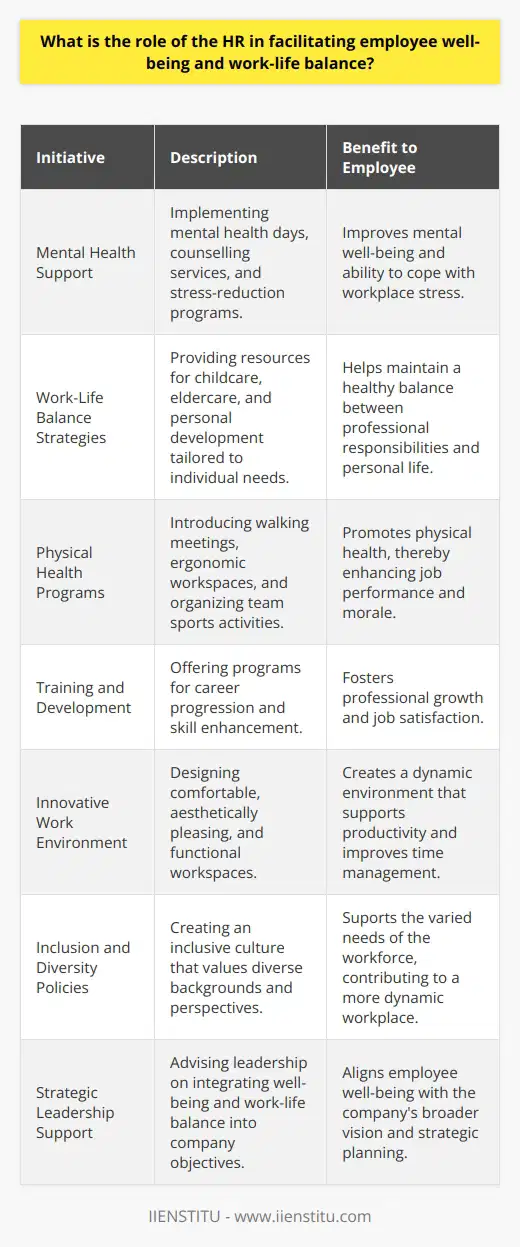
In the context of globalization and the emerging gig economy, what is the best HR definition that encompasses the changing dynamics of the workforce?
Globalization and the Gig Economy Impact on HR Definitions
The traditional role of Human Resources (HR) has evolved significantly in response to the forces of globalization and the rise of the gig economy. Managing a diverse and flexible workforce demands an updated HR definition that takes into account the changing dynamics of the workforce. Given these developments, the optimal definition of HR can be described as: the strategic planning, implementation, and evaluation of policies and practices to effectively engage, develop, and retain individuals from varied cultural, geographic, and professional backgrounds who contribute to the organization's success through both short-term and long-term employment relationships.
Encompassing the Diversity of Work Arrangements
One crucial aspect of the adapted definition lies in its recognition of the varying nature of employment relationships. It encompasses not only traditional full-time, permanent workers but also considers the reality of short-term, freelance, and independent contractors prevalent in the gig economy. By doing so, the definition emphasizes the need for organizations to be adaptable and prepared to manage the complexities of a diverse workforce.
Addressing Cultural and Geographic Influences
Globalization has created a multinational workforce resulting in cross-cultural diversity, making it essential for the HR definition to address cultural and geographic influences. The inclusion of these factors necessitates HR professionals to develop cultural competence, understand legal and statutory requirements across different regions, and tackle language barriers.
Integrating Strategic Workforce Planning
The new definition highlights the increasingly strategic role of HR. This involves integrating workforce planning in the organization's overall business strategy, anticipating global labor market trends, and ensuring the alignment of HR policies with the organization's objectives. It also implies HR's contributions to the bottom line by enabling the organization to capitalize on opportunities and overcome challenges brought about by globalization and the gig economy.
Recognizing the Importance of Talent Development
The revised HR definition underscores the need to effectively develop and retain talent in a competitive global landscape. This entails investing in training and development initiatives, fostering inclusive work environments, and providing support to a diverse workforce to ensure a continuous pipeline of skilled and adaptable talent, ready to contribute to the organization's success.
In conclusion, the best HR definition in the context of globalization and the gig economy should reflect the altering dynamics of the workforce. By acknowledging diverse work arrangements, cultural and geographical factors, strategic workforce planning, and talent development, the proposed definition provides a comprehensive framework for HR professionals navigating this new era of work.

What is the meaning of Human Resource Management with regards to conflict resolution and creating a harmonious work environment?
Understanding Human Resource Management
Human Resource Management (HRM) plays a crucial role in establishing and maintaining a harmonious work environment. It refers to the process of dealing with personnel-related matters within an organization, including recruitment, development, training, employee welfare, and conflict resolution. HRM aims to optimize employee performance and promote a positive organizational culture, which has a direct impact on the overall productivity and success of the organization.
Conflict Resolution Strategies
Conflict resolution is an essential aspect of HRM, as it is necessary to address and manage disputes that arise between employees. By employing effective conflict resolution strategies, HRM can prevent escalated tensions and maintain a healthy workplace. Some of these strategies include open communication, mediation, negotiation, and problem-solving. HRM professionals must be skilled in identifying the root causes of conflicts and developing appropriate solutions to resolve disagreements and tensions amicably.
Creating a Harmonious Work Environment
A harmonious work environment is one where employees feel valued, respected, and motivated to perform at their optimal level. HRM plays a vital role in fostering positive interpersonal relationships and promoting a collaborative, inclusive, and supportive workplace. Some key elements that contribute to a harmonious work environment include equitable policies, employee engagement, and constructive feedback. Additionally, HRM initiatives that focus on employee wellness, work-life balance, diversity and inclusion, and recognition and rewards are also significant contributors to a harmonious work environment.
In conclusion, Human Resource Management plays a critical role in conflict resolution and establishing a harmonious work environment within an organization. By implementing effective strategies and initiatives that promote open communication, teamwork, employee well-being, and inclusivity, HRM ensures that employees remain motivated, engaged, and productive, leading to organizational success.



